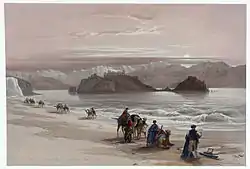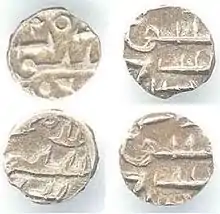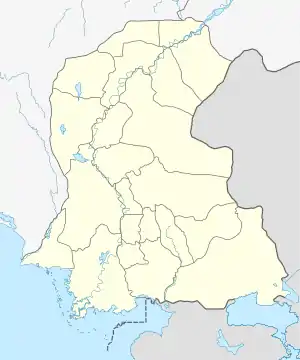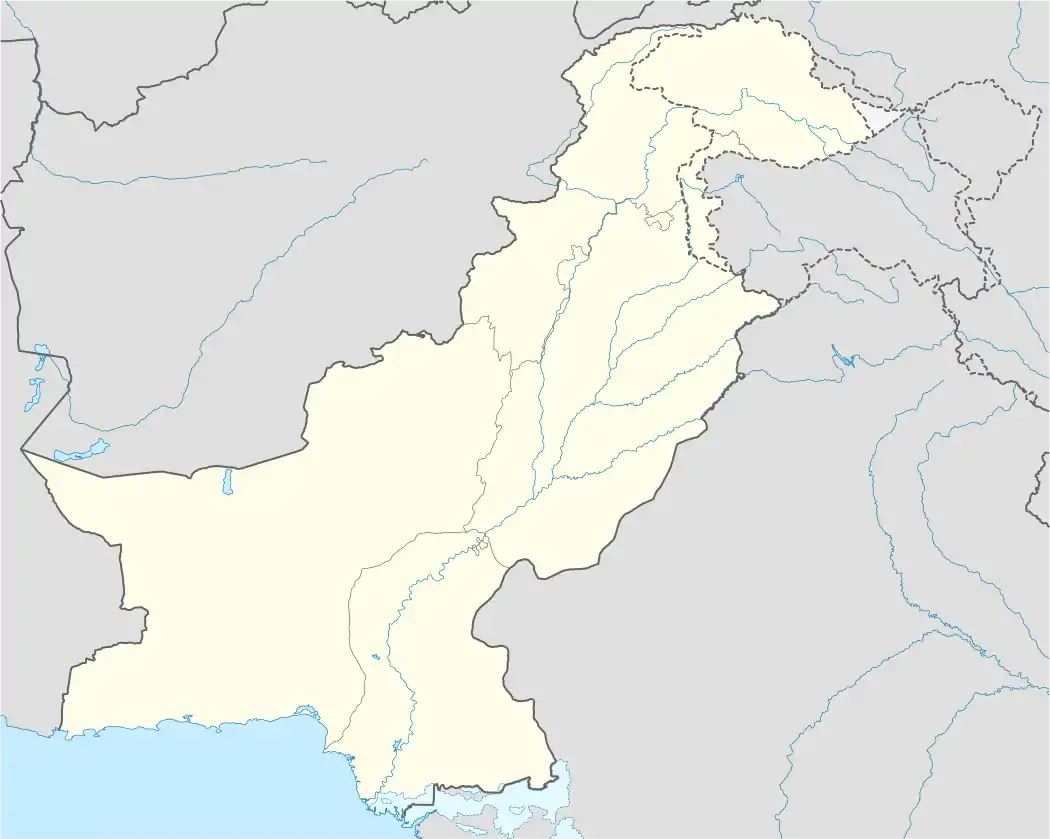Mansura, Sindh
Mansura (Arabic: المنصورة, al-manṣūrah), referred to as "Brahmnabad" in later centuries,[1] was the historic capital of the Muslim Caliphate in Sindh, during the eighth century under the Umayyad Caliphate and then Abbasid Caliphate [2][3] from the year 750 AD to 1006 AD. The city was founded as a central garrison by the Umayyad Forces in Sindh, the city transformed into a very vibrant metropolis during the Abbasid Era surpassing the wealth of Multan in the north and Debal in the south. Mansura was built on the shores of the Indus River, it was surrounded by fertile farmland, Ibn Hauqal mentioned the wealthy local merchants who wore Baghdad Costume and were of Sindhi-Arab origins, houses were made of clay, baked bricks and plaster.

منصورہ (in Urdu) | |
 Coins during the rule of Amirs of Sind, c. 257 -- 421 AH / c. 870 -- 1030 AD | |
 Shown within Sindh  Mansura, Sindh (Pakistan) | |
| Location | Sanghar District, Sindh, Pakistan |
|---|---|
| Coordinates | 25°52′52″N 68°46′37″E |
| Type | Settlement/Capital City |
| Part of | Umayyad Caliphate and Abbasid Caliphate in Sindh |
| History | |
| Periods | Caliphal Period (Umayyad Period) (Abbasid Period) |
| Cultures | Islamic Golden Age |
Mansura exported herbs and spices, textiles, ivory, metals and mirrors to Baghdad. There were some renowned educational institutions in the city, Mansura produced the first translation of the Quran in the Sindhi language, it was used widely throughout the Indus region. The city was the hometown of famous historical figures such as Sind ibn Ali he introduced the Arabic numerals and the Zij al-Sindhind; Abu Mashar Sindhi is described by many historians and chroniclers as a pioneer in the compilation of Hadith; Abu Raja Sindhi lived in Baghdad and engaged in scientific and literary pursuits they translated a large number of ancient books of South Asia on mathematics, astronomy, astrology, medicine, literature and ethics into Arabic. According to geologists an earthquake struck both Debal and Mansura in the year 893.AD, the city was later ruled by the Soomro Emirs. Mansura was sacked by the forces of Mahmud of Ghazni because the inhabitants feared his reputation and refused to open the gates. The city never recovered and its Soomro Emirs were deposed.
The city now lies 18 kilometres (11 mi) south-east of Shahdadpur[4] and 75 kilometres (47 mi) north-east of Hyderabad.[1]
Overview
Archaeological remains have been found in the ruins of Mansura (Brahmanabad) in central Sindh before the arrival of Arab general Muhammad bin Qasim. It was mentioned in historical references, but recent scientific research by the Department of Archeology at Shah Abdul Latif University has proved that there are traces of a third-century AD population.
When was the Mansura (Brahmanabad) excavated?
Bellas and Richardson first excavated these archeological sites in 1854, then Henry Cousins carried them forward. After the formation of Pakistan, excavations were carried out by the National Ministry of Archeology in 1962. The initial report was published but the comprehensive report has not been published till date. In this report, Dr. F. A. Khan stated that these are the relics of Mansura city and the relics of the mosque have been found here while the pre-Islamic relics are not available. Dr Ghulam Mohi-ud-Din Weisser, of the Department of Archeology at Shah Abdul Latif University, said the report did not address the level of buildings or periods.
What is the purpose of recent research?
A group of 20 teachers and students led by Dr. Ghulam Mohi-ud-Din Weiss, Head of the Department of Archeology, Shah Abdul Latif University, has been conducting research on the archeological site of Brahmanabad in recent days. The phase will be expanded. Dr. Ghulam Mohi-ud-Din Weisser says, "We want to see if the assumption that this population was formed when Muhammad bin Qasim came is correct or not. The pots are being found and what century and periods they reflect. It may be recalled that Muhammad bin Qasim had invaded Sindh in 712 AH on the orders of Hajjaj bin Yusuf, the ruler of Baghdad. At that time, Raja Dahir was ruling here.
Signs of ancient residence under the Mosque
Dr. Ghulam Mohi-ud-Din Weisser says that earlier research mentions a mosque, so he has dug four pits in the mosque area, which have gone down 15 feet, which shows that the current city Even before that there was a population. According to him, there is a difference in the surface of the buildings that are being found here or the pottery that is being found here and there are signs of the Islamic era and also include the pre-Islamic periods. "The pottery found here bears a resemblance to the third century AD and dates back to the Sassanid period (the last kingdom of Iran before Islam). Similar pottery has been found in the Bhanbur archeology," he said. "On this basis, it can be said that this city was inhabited from the third century. If we look at its spread, we say that when Muhammad bin Qasim came here, he conquered it, but the people were already settled here."
Precious stones and jewelry
Research on Mansura (Brahmanabad) also suggests that the city may have been a hub of economic activity. An earlier study found coins and other artifacts that had been moved to the British Museum and Bombay before the establishment of Pakistan. Dr. Weiss says that recent research has found pottery, as well as precious stones, sapphires, rubies, and emeralds, as well as polishing tools and molds. "Which, of course, made the video an overnight sensation. In addition, ivory ornaments, shells and coins have been found and after cleaning the coins, it will be known what time they are.
Groundwater system
Like Mohan Jo Daro and Bhambhur, drinking water wells have been found in Mansura (Brahmanabad) but they are unique. Dr. Ghulam Mohi-ud-Din explains that like the pottery, a line of colored pipe made in the furnace is going down to less than fifteen feet. This line was made by mixing these colors together. This line is running vertically to get groundwater, it is a unique technology of its kind, in previous research this line was called drainage line.
A city with four gates
Mansura (Brahmanabad) contains historical material in various languages, including Arabic and Persian, which show the existence of this city. Mirza Kalich Baig, a Sindhi language historian and playwright, writes in Ancient Sindh that Brahmanabad was one of the seven great fortified cities during the reign of the Hindu kings. In the reign of Brahman Raja Chach, Agham Lohana was the ruler of this place, Lakha, Sama and Sahta were under his influence. His order extended to the sea, that is, to the port of Debal. Chach fought and defeated Agham and took control of the city and married Agham's widow. He further writes that when Raja Dahar, the son of Chach, became the ruler, he appointed his brother Dahar Sien as the ruler of this place and after his death his son was given the rule. Molawi Shedai writes in Janat-ul-Sindh that there was a large Buddhist shrine there and astrologers were present there. Despite being a strict Brahmin, Chach maintained a Buddhist shrine. Dr. Weisser says that in the first study it was said that there is a Buddhist stupa here but the relevant material of its features or symbols is not available because the Buddha stupa has different features, no statue or statue of such a Buddha is found. ۔
Arrival of Muhammad bin Qasim
In 'Janat-ul-Sindh', Molawi Shaidai writes that after the assassination of Raja Dahir, his son Jaseen had 15, including Muhammad Alafi (Muhammad Alafi had revolted against the Caliph in Oman and Raja Dahir had given him refuge over his failure). There was an army of a thousand. The two were advised by the Minister of Politics to go to Mansura (Brahmanabad), where many treasures were buried. The four gates of the fort of Brahmanabad were Jir Bedi (boat) Sahtia, Manhro and Salbah. According to him, this was the last battle of the Sindhis against Muhammad bin Qasim.In the month of Rajab, the Arab army reached near Mansura (Brahmanabad), trenches were dug on the orders of Muhammad bin Qasim, Jaisin started a guerrilla war and devastated the whole area so that the Islamic army could not get supplies and animals. After a month's siege, defeat ensued and the citizens opened the gates of the fort. Muhammad bin Qasim appointed Jizyah on them. This victory took place in Muharram in the year 94 AH.
The city of the Iranian king
Some scholars believe that Mansura (Brahmanabad) was settled by the Iranian king. Ghulam Ali Allana, a scholar and historian from Sindh, writes in his article 'Ismaili rule over Mansura' in Mehran magazine that the ruler of the Sassanid dynasty Handed over the government of the Indus Valley to his grandson Bahman, known in the history of Iran as 'Human Ardeshir Darad Dast' Bhaman settled a city in Sindh called Bhamano which later became known as Brahmabad. Some Arab tourists described Brahmabad and Mansura as one city. Al-Mansura is another name for Brahmanabad, he writes, quoting Yaqut Lahumi, Hamza. According to the Arab tourist Al-Biruni, the name of Brahmanabad is Bhamanwa. Before the rule of Muslims, this city was called Brahmanabad. Sindh researcher and historian Dr. Nabi Bakhsh Baloch also supports Dr. Allana's opinion. He says that Brahmanabad was built on the orders of Bahman Ardeshir and probably after a long time when the influence of Brahmans in Sindh increased, the name of Brahmanabad came to be called Brahmanabad. This change was due to the domination of the Brahmins or the local payment of the Sindhi language.
Brahmanabad or Mansura
Researchers believe that due to military and political needs, the Arabs had to settle their cities in Sindh, of which Mahfouzah, Beida and Mansura became famous. Elliott quotes Blazeri as saying that Brahmabad was far from Mansura, with the view that a large part of Brahmabad was included in Mansura and Mahfouzah was settled next to it. Sindh historian MH Panhwar writes that historical evidence shows that Brahmanabad and Mansura are two names of the same city. In the time of Yazid al-Qalbi, the capital of Sindh was shifted from Alwar to Mansura. Bashari al-Maqdisi, who visited Sindh in 961 AD, wrote in his book Ihsan al-Taksim Ma'arif al-Kalim that Mansura is a city one kilometer long and two kilometers wide with a river on all four sides and four gates. According to him, Mansura is equal to Damascus in its territory. The houses are made of mud and wood but the Jama Masjid is made of stones and bricks and is a nice big building in the middle of the city.
Mahmoud Ghaznavi's attack
Mansura (Brahmanabad) was also attacked by Mahmud Ghaznavi. M. H. Panhwar writes that after the attack on the Somnath temple, Mahmud Ghaznavi attacked Mansura. There was a government of Khafif Soomro who fled before the attack. has been. Panhoor writes that Farkhi, the court poet of Mahmud Ghaznavi, in his ten-line poem, mentions people fleeing in the palm groves of Khafif, digging in the river to save lives and massacre. Citing Henry Keynes, Panhoor writes that the way coins were found in the streets suggests that looting had taken place. Some historians believe that Mahmud Ghaznavi came to Mansura on his return after the attack on Somnath in present-day Indian Gujarat and attacked Multan after the attack here. However, MH Panhwar disagrees. Dr. Ghulam Ali Allana writes that the pioneer preacher of the Shiite movement, Al-Ashtar, first arrived in Mansura and at that time was the time of the caliphate of Abu Ja'far Mansur Abbasi and the Mansura of Umar bin Hafs He was a supporter of Sadat and invited him, who summoned influential people of the city and decided to take the oath of allegiance on a Thursday, but the news reached Baghdad and al-Ashtar had to flee.
How did the fall of Brahmanabad or Mansura come about?
Bellas and Richardson, who had previously excavated here, believe the quake devastated the city. Ghulam Mohi-ud-Din, head of the archeology department at Shah Abdul Latif University, rejects the theory of earthquakes because "the walls are intact and not bent anywhere." He also disagrees that the city was attacked and set on fire. According to him, "no traces of fire or burnt wood have been found." M.H Panhwar believes that the historical record shows that the Hakra River dried up and the Indus River also changed its course, these changes took place in the region in the 10th century AD. Dr. Weiss also thinks that the Indus may have changed its course, affecting its communications and facilities. According to him, the later found building structure is not as good as that of those who came before him who built houses later.
History
Erstwhile name of this city was Brahmanabad, which was renamed as Mansura by the Arab invaders.[5] The Umayyad governor of Sind, Al-Hakam, founded a city called al-Mahfuza later called Brahminabad. Historical sources state that he found there were "no places in Sind where Muslims were safe", which indicates there were unrest and rebellions before his arrival.[6] His deputy Al-Thaqafi founded Al-Masura "opposite Al-Mahfuza". Historian Blankship believes that the former was a base for the Yamani troops of the Caliphate and the latter was for the Mudari troops.[6] By the time of Al-Baladhuri, the old Brahamanabad was in ruins, and the new city itself was referred to by the name Brahmanabad.[1]
The city was further developed by Khalid ibn Barmak (705–782), a member of the Persian Barmakids family, during the Abbasid Caliphate. The city holds an important position in Muslim history as the first to be built by Arabs according to the principles of town-planning. Seventeen years later, lessons learned in Mansura were applied in Baghdad where there were once numerous Sindhi inspired buildings and monuments.
Mansura's history began under the Umayyad Caliphs, when Muslim Arabs attempted to conquer the frontier kingdoms of India, Kabul, Zabul, and Sindh. In the early 8th Century, with the Kingdom of Sindh convulsed by internal strife, the Arabs seized their chance and renewed their attacks. Thereafter it was captured by Muhammad ibn Qasim, nephew of al-Hajjaj ibn Yusuf, the governor of Iraq and Khurasan with the Arab Muslim army now known as Arain .Qasim's successors attempted to expand from Sindh into the Punjab and other regions. Al-Masudi ascribed the foundation of the city to Governor Mansur ibn Jamhur, the last Umayyad governor of Sindh. Umar ibn Abd al-Aziz, who belonged to the Banu Habar tribe, the clan of Banu Asad, was the first governor of al-Mansura. Under the Caliphate of al-Mansur, Khalid was appointed governor of Fars and, after helping obtain Prince Isa ibn Musa's renunciation of his succession to the caliphate in 765, became governor of Tabaristan. Around the same time, his son Yahya ibn Khalid, was appointed governor of Adharbayjan.
According to historians, Mansura was a beautiful town with vast orchards of mangoes and groves of date palms. Today the ruins of Mansura are spread over an area 4 miles (6.4 km) in circumference near the modern city of Shahdadpur. The most significant ruin found in Mansura is the large courtyard of a Jamia Masjid (mosque).
Modern ruins
The city lies upon the open sandy plain amongst rolling heaps of brick debris, crisscrossed with the depressions of its original streets and surrounded by the ruins of its once massive walls and bastions. Shaped like a boot with the sole facing north-west and the leg stretching south-east, the whole area has a circumference of 5.75 miles (9.25 km). Apart from a considerable area towards the south-east end, the whole space is covered with billowing mounds of brick ruins. Nothing now stands above the surface, except in one place, where an unrecognizable tower-like core of brick masonry remains. There is a total absence of stone masonry of any kind, but lumps of charred wood dotted here and there indicate the former presence of woodwork. The cement used in the brickwork appears to have been mud which forms the greater mass of the present mounds. As per historian Rahimdad Khan Molai Shedai,"Brahmanabad town was located within 4 miles area, where in the temple named Nu Wihar there was an idol of Buddha. In various history books on Sindh said temple was also written as Nu Bahar which is varied form of Nu Wihar. As Byblion temple priests were astrologers or fortune tellers like priests of Brahmanabad were also great astrologers. The staunch Brahaman king like Chach had to kneel before them and constrained to renovate the temple. The number of the priests in the town was around 1000'.[7]
In the initial excavation of the urban complex of Brahmanabad-Mansurah-Mahfuzah, A. P. Bellasis uncovered a seal bearing the Arabic inscription "Imam al-Baqir"[8] which appear to belong to the fifth Shi'ite Imam Muhammad al-Baqir (677–733 AD).
See also
References
- Wink, Al-Hind, Volume 1 1996, p. 185.
- Ruins of Mansura city in Sindh Pakistan, National Geographic, 29 May 2017.
- Hussain, Irshad. (1989). Mansurah - The First Capital of Muslims in Sindh. Journal of the Pakistan Historical Society 37(3): 293-303.
- Blankinship 1994, p. 335.
- "برهمڻ آباد: تاريخ جي آئيني ۾:محبوب علي چنا". Awami Awaz (in Urdu). 2019-10-26. Retrieved 2020-06-15.
- Blankinship 1994, pp. 186–187.
- Rahimdad Khan Molai Shedai; Janat ul Sindh, 3rd edition, 1993, page 63;Sindhi Adbi Board, Jamshoro
- A. F. Bellasis, "An Account of the Ancient and Ruined City of Brahminabad, in Sind," JBBRAS 5 (1856) :421. As cited in: Derryl N. Maclean," Religion and Society in Arab Sind", p. 127, BRILL, (1989) ISBN 90-04-08551-3.
Bibliography
- Blankinship, Khalid Yahya (1994). The End of the Jihâd State: The Reign of Hishām ibn ʻAbd al-Malik and the Collapse of the Umayyads. Albany, New York: State University of New York Press. ISBN 978-0-7914-1827-7.
- Wink, André (1996) [first published 1990], Al-Hind: The Making of the Indo-Islamic World, Vol 1: Early Medieval India and the Expansion of Islam (Third ed.), Brill, ISBN 0391041738
Further reading
- Avari, B. (2012). Islamic civilization in South Asia: A history of Muslim power and presence in the Indian subcontinent. London: Routledge.
- Rashid, N. (1998). Al-Mansurah-The Lost City. Journal of the Pakistan Historical Society 46(4).
- Mansura Archaeological Site Photo
- Sindh Archaeology